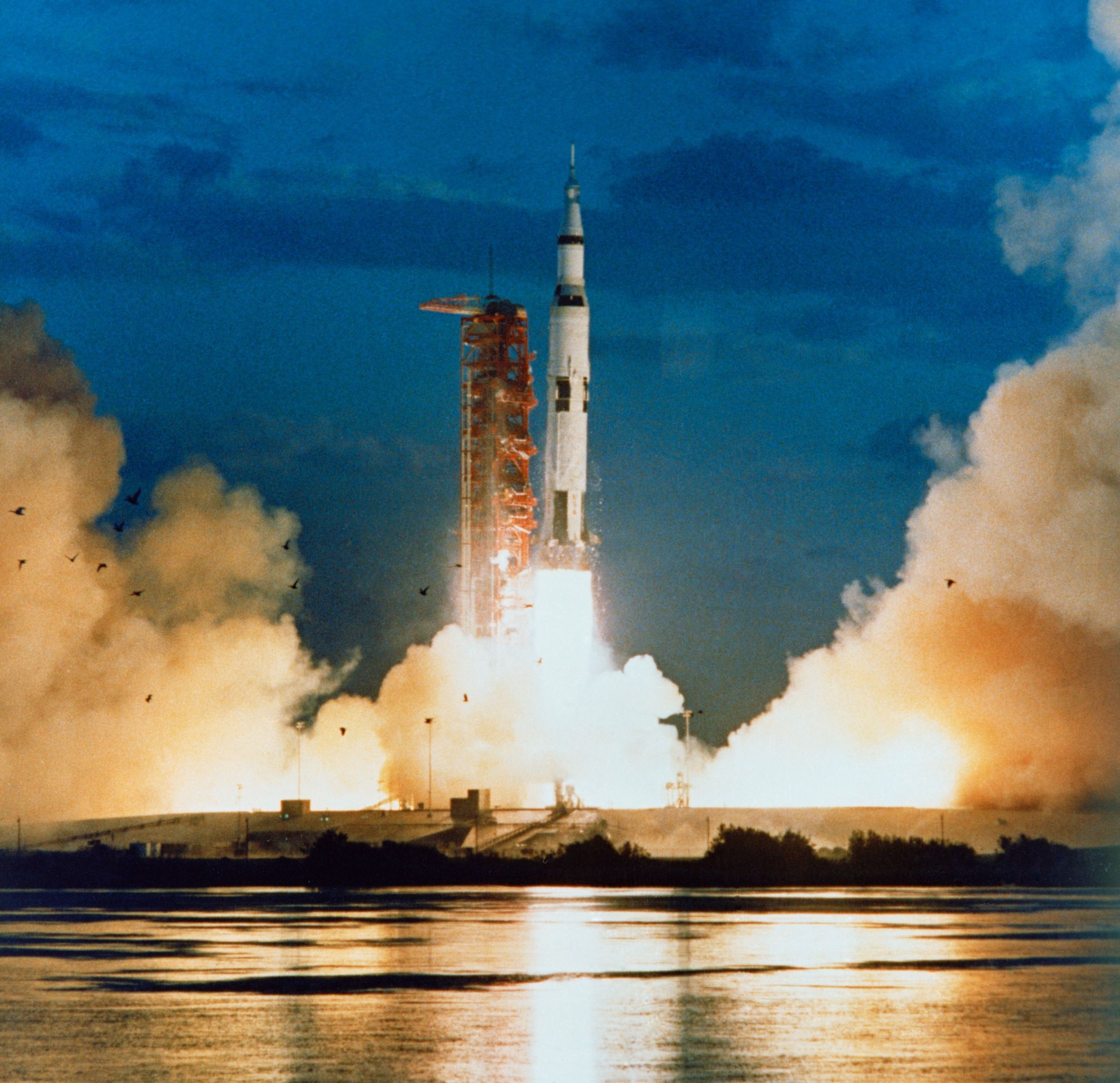The Saturn V rocket for the uncrewed Apollo 4 mission was the first flight vehicle stacked in the Vehicle Assembly Building, or VAB, and the first to lift off from the Kennedy Space Center. The mission’s historic rollout to the launch pad took place 45 years ago this summer.
That first launch from Kennedy paved the way for flights that would take Apollo astronauts to orbit around the moon and land on its surface. In the late 1970s, modifications prepared the pads for three decades of space shuttle missions. Another round of upgrades, already in progress, are laying the groundwork for multiple launch vehicles including NASA’s Space Launch System, which could take astronauts farther into space than ever before.
Apollo 4’s rollout began early on Aug. 26, 1967. Scores of news reporters from around the world were on hand to record the event as the 363-foot-tall Saturn V atop the mobile launcher and crawler transporter made for an 18 million pound vehicle. It lumbered along at less than 1 mile per hour on its way to Launch Pad 39A, about three miles away.
The crucial Apollo 4 mission was an “all-up test,” meaning all rocket stages and the spacecraft were fully functional on that initial flight, an unprecedented step for NASA at the time.
“All the elements that constitute the launch vehicle were, for the first time, put together here and put to the test,” said Dr. Kurt Debus, Kennedy’s director at the time.
The big exam came on Nov. 9, 1967 and Saturn passed with flying colors. The five massive engines in the first stage ignited, building up to 7.5 million pounds of thrust. The Saturn V slowly lifted off the pad as the Firing Room erupted in cheers from members of the launch team. The shock waves buffeted the Press Site as Walter Cronkite, reporting for CBS News, held the plate glass window in his broadcast booth as it threatened to fall in.
The flight lasted almost nine hours, with the command module splashing down in the Pacific Ocean. The mission was declared a complete success, demonstrating the structural and thermal integrity of the Saturn launch vehicle and Apollo spacecraft.
“It was really an expert launch all the way through, launching exactly on time to performance of every single stage,” said Dr. Wernher von Braun, director of the Marshall Space Flight Center where the Saturn had been designed.
Maj. Gen. Sam Phillips, NASA’s Apollo program manager, also had high praise for the people of Kennedy.
“I was tremendously impressed with the smooth teamwork as the combined government/multi-industry team pulled together,” he said. “It was smooth, it was professional, it was confident.”
Between 1967 and 1975, 13 Saturn Vs and 4 Saturn 1Bs launched from Pads 39A and B. During the late 1970s the pads were modified for the space shuttle. In a 30-year span, 135 shuttle missions were flown. The final shuttle launch, Atlantis on the STS-135 mission, lifted off from Pad A in July 2011.
Pad 39B was last used for the Ares I-X launch in October of 2009. Modifications to Pad B began right after Ares I-X.
“With new systems, upgrades and refurbishment to Pad B, it will be almost like new,” said Jose Perez-Morales, NASA’s Pad Element Project manager for Ground System Development and Operations program. “All of the Pad systems and structures will either be refurbished or modified for the future vehicles. Work is on schedule to have the pads ready by 2017.”
Unlike the Apollo and shuttle eras, Pad 39B of the future will have the ability to support multiple types of launch vehicles, including commercial rockets and NASA’s Space Launch System, or SLS, and its Orion spacecraft. SLS will be an advanced heavy-lift launch vehicle providing a new capability for human exploration beyond low Earth orbit.
After the last shuttle launch from Pad 39B, three 600-foot-tall lightning protection towers were built. Following the Ares I-X flight, the fixed and rotating service structures were dismantled. However, there is more here than meets the eye.
“That’s the visible part of the work,” Perez-Morales said. “There’s a great deal more. Each lightning tower has a compete weather station. Data will be collected on four levels which can be relayed to the firing room.”
More than 1.3 million feet of cables, some dating back to the Apollo era, has been removed and replaced with fiber optics. All the shuttle era electronic systems also have been removed and upgraded with state-of-the-art hardware. A new “universal” flame deflector is being designed for use not only with SLS, but for various commercial vehicles. Propellant storage tanks have been completely drained, and they are being refurbished and painted.
“The liquid hydrogen and liquid oxygen propellant tanks should now be ready to support launch operations for the next 20 to 30 years,” said Perez-Morales.
In other ways, some future systems will more closely resemble Apollo.
“One example of this is having the launch umbilical tower back on the mobile launcher. With this configuration, we can complete a great deal of the pre-launch preparations in the VAB,” said Perez-Morales.
During the shuttle program, the vehicles were rolled to the pad 30 to 60 days prior to launch. That time factor should be reduced considerably in the future.
“Much of the work at the pad during shuttle involved completing the many connections between the vehicle and the pad tower,” he said. “Doing more in the VAB also reduces the exposure to the elements and the delays caused by Florida’s all too familiar thunderstorms.”
Apollo 4 opened a new era 45 years ago. In 1981, STS-1 began the second generation of vehicles launching to space from Florida’s spaceport. Preparations already are well underway for Kennedy’s third era of exploration.



























